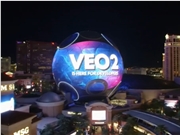ShengShu Technology officially launched Vidu Q1, a high-performance generative AI video model, sparking industry buzz with its exceptional visual quality, smooth cinematic transitions, precise audio effects, and enhanced animation styles. According to AIbase, Vidu Q1 surpasses existing competitors in the VBench comprehensive video generation evaluation standard, offering creators a professional-grade filmmaking experience thanks to significant upgrades across its four core functions. Project details have been released on the Vidu website and social media platforms, marking a new milestone in AI video generation technology.

Core Features: Four Upgrades Empower Immersive Creation
Vidu Q1 achieves comprehensive optimization from visuals to audio through technological breakthroughs. AIbase has outlined its four core features:
Exceptional Image Quality: Supports up to 1080p video output, with sharper frames, richer textures, and detail comparable to professional VFX. For example, when generating anime characters, clothing folds and lighting effects are clearly visible.
Cinematic Transitions: Utilizing "First-to-Last Frame" technology, it ensures seamless transitions between frames, supporting natural transitions in complex scenes. Users can upload two images and input text prompts (e.g., "Open the door to reveal a hero and villain battle") to generate high-fidelity cinematic effects.
Precise Audio Effects: Industry-first 48kHz high-definition AI audio generation, allowing users to customize sound effects and background music via text prompts (e.g., "Add wind sound from 0-2 seconds"). It automatically matches the video's mood and style, eliminating compression distortion and jarring audio.
Enhanced Animation Style: Optimized for anime styles, resulting in more consistent and expressive character expressions and movements, producing more stable results, especially suitable for Japanese fantasy and surreal anime creation.
AIbase noted that in a community demo, Vidu Q1 generated a 5-second 1080p video from two unrelated images, showcasing its powerful potential in rapid content creation with natural transitions and precise audio.
Technical Architecture: Semantic Understanding and Multimodal Fusion
Vidu Q1 is based on ShengShu's U-ViT architecture, combining Diffusion models and Transformer technology to significantly improve semantic understanding and generation efficiency. AIbase analysis reveals key technologies including:
Advanced Semantic Processing: With enhanced text understanding capabilities, Vidu Q1 accurately parses complex instructions to generate video content that follows narrative logic.
Multimodal Generation: Supports text-to-video, image-to-video, and mixed input, allowing users to upload multiple images to ensure character and scene consistency.
Efficient Rendering: Optimized rendering process, generating a 5-second 1080p video in just seconds, eliminating the long wait times associated with traditional rendering.
Audio Control: Supports up to 10 seconds of multi-track audio layering, allowing users to precisely control the insertion points of sound effects and music using timestamps.
Vidu Q1's "My References" feature further enhances creative efficiency, allowing users to save characters, props, and scenes for reuse, ensuring consistency in long-term projects.
Application Scenarios: From Social Media to Professional Filmmaking
The release of Vidu Q1 offers broad application prospects for creators across multiple fields. AIbase summarizes the main scenarios:
Social Media Content: Bloggers and influencers can quickly generate viral videos, such as "hugging an idol" or "anime-style shorts," to enhance fan interaction.
Film and Advertising: Independent filmmakers and small studios can use Vidu Q1 to generate high-quality pre-visualization or special effects sequences, reducing post-production costs.
Game Development: Generate dynamic character animations and scene transitions, accelerating prototype design and level development.
Education and Training: Educators can create engaging instructional videos, combining anime styles and precise audio effects to improve student engagement.
Community feedback indicates that Vidu Q1's anime generation capabilities are particularly outstanding, lauded as the "best choice for anime AI video generation," with its rapid generation and high-fidelity output receiving consistent praise from creators.
Getting Started: Simple Operation, Free Trial
AIbase understands that Vidu Q1 provides an intuitive interface through the Vidu Studio platform, supporting web and API access. Users can quickly get started by following these steps:
Visit the Vidu Studio website (www.vidu.studio), register, and obtain free trial credits (approximately 30 credits are consumed per generation).
Select "Text-to-Video" or "Image-to-Video" mode, upload images, or input text prompts.
Set the style (e.g., anime or realistic) and audio instructions, and click "Create" to generate the video.
Preview and download the 1080p video, supporting export to tools like Filmora for post-editing.
Vidu Q1 currently supports image-to-video and text-to-video functions, with the Reference mode expected to be updated later. Hardware requirements are low; a stable internet connection is sufficient for smooth operation. AIbase recommends using detailed prompts to optimize generation results, such as "Sci-fi city night scene, camera swooping down from high altitude, accompanied by electronic sound effects."
Community Feedback and Future Outlook
Following the release of Vidu Q1, the community has given high praise to its image quality, transitions, and audio performance. Developers call it "bringing cinematic VFX to the hands of ordinary creators," particularly excelling in anime and short video creation. However, some users have suggested adding longer video generation durations (e.g., 16 seconds) and multilingual support. ShengShu Technology responded that future updates will optimize the Reference mode and explore 3D generation and real-time interaction features. AIbase predicts that the success of Vidu Q1 will drive AI video generation towards multimodal and high-efficiency directions, potentially integrating with tools like Blender and Unity to build a complete AI creation ecosystem.








